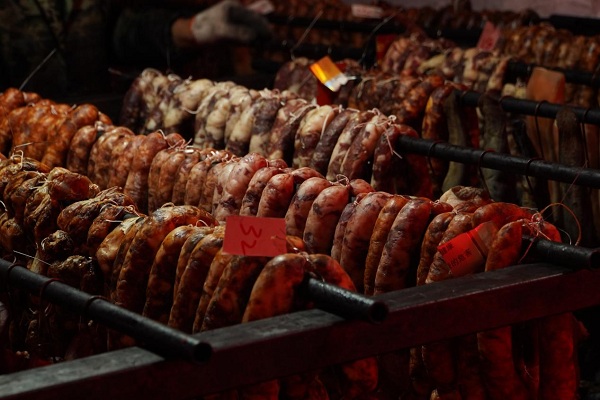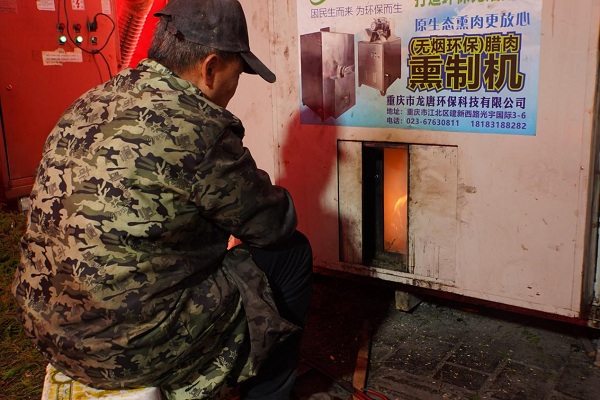Time-honored festive meat curing continues in metropolis
Guo Shuyu and Dong Guannan
Updated:2022-01-04
english.liangjiang.gov.cn
The anticipation and build-up to the Chinese New Year on Feb 1 are gradually swelling in the chill air of December and it is now only weeks away before the grand traditional holiday arrives, many households are now tucking into their first bites of the festival season – smoked bacon and sausages.
At the break of dawn, Shu Tong, a veteran smoked meat producer, arrives at a smoking site in a quiet neighborhood in the Liangjiang New Area. His job is to run the smoker – the special machine for making the smoked meat – and to ensure all the cuts sent there are properly done.
It is a medium-sized red hut, with two smokers in the corner, next to which are the sausages and other meat hanging on the racks, ready to be smoked or picked up.
 |
| Cured sausages hang on racks, waiting to be smoked. [Photo by Dong Guannan] |
Another hectic day lies ahead for Shu and his workmates. At 8 am, he starts up the smoker.
Wood sticks are placed inside to keep the fire going, then cypress twigs, whose aroma will be absorbed by the meat cuts during the process, with a thick layer of chaff added on top, producing the heavier smoke to get the job done.
"When the temperature hits 50 C inside, I put out the flame and let the smoke do its work," says Shu, who sits in front of the smoker and controls the heat with care. "It's the old-fashioned way and takes patience and time, usually three to four hours, before each batch is done."
 |
| Shu sits in front of the smoker and controls the heat with care. [Photo by Dong Guannan] |
Among the first customers was Wu Jianying, in her 70s, who came along with her youngest son. They brought 35 kilograms of cured cuts to be processed.
Wu had already spent days on the preparations. The meat came from a relative who raised pigs in her hometown, a small village 140 miles away.
"I left my hometown for Chongqing about 10 years ago. Every year, I buy a whole pig from my hometown before the Spring Festival, like many people who migrate to the city. It's my connection with where I was born and raised," Wu said.
Meat cuts need to be cured and wait for another few days for the rich flavors to develop and the meat to dry. Although salt, pepper, sugar are mostly used, each household is likely to have its own recipe for a special taste.
"We can easily buy smoked sausages and bacon from supermarkets, but my family prefers homemade ones. I prepare both sweet and spicy sausages. The sweet ones are for my great-grandson. He likes them a lot," Wu said.
In the same afternoon, her smoked meat will be ready for pick-up. Two days later, her great-grandson will be home from university and share the food and happiness of the New Year with her.
Like Wu's family, many households in Southwest China make smoked meat as part of their cherished New Year's routine.
The smoking process was developed by rural folks in bygone times as a food preservation method. Smoking meats before the Chinese New Year has become an age-old practice in rural China.
Rapid urbanization, however, has seen conflict develop between some traditional habits and city life. In 2015, smoking meats at home was banned by Chongqing to prevent air pollution.
To enable this long-held tradition to survive, the local authority has set up dozens of smoking sites equipped with eco-friendly smokers this year, which helps residents observe the ceremonial routine without befouling the atmosphere.
Zhang Youlun, who runs one site, said the smokers are equipped with filters. "The smoke will be filtered before being emitted into the open air, with minimized pollution," he added. Hazardous substances in the smoke are extracted and turned into solid waste, which is then collected and handled in an eco-friendly way. "Many people in the neighborhood come with cured cuts," Zhang said.
"We can have 1,500 kilograms of meat done each day." Zhang said his family has smoked sausages and bacon in early December, which is what they do every year: "the way we do it changes for the better, but the old tradition stays."
Video

John Edwards, the UK trade commissioner for China, praised Chongqing over its rise as a burgeoning center in intelligent manufacturing.





